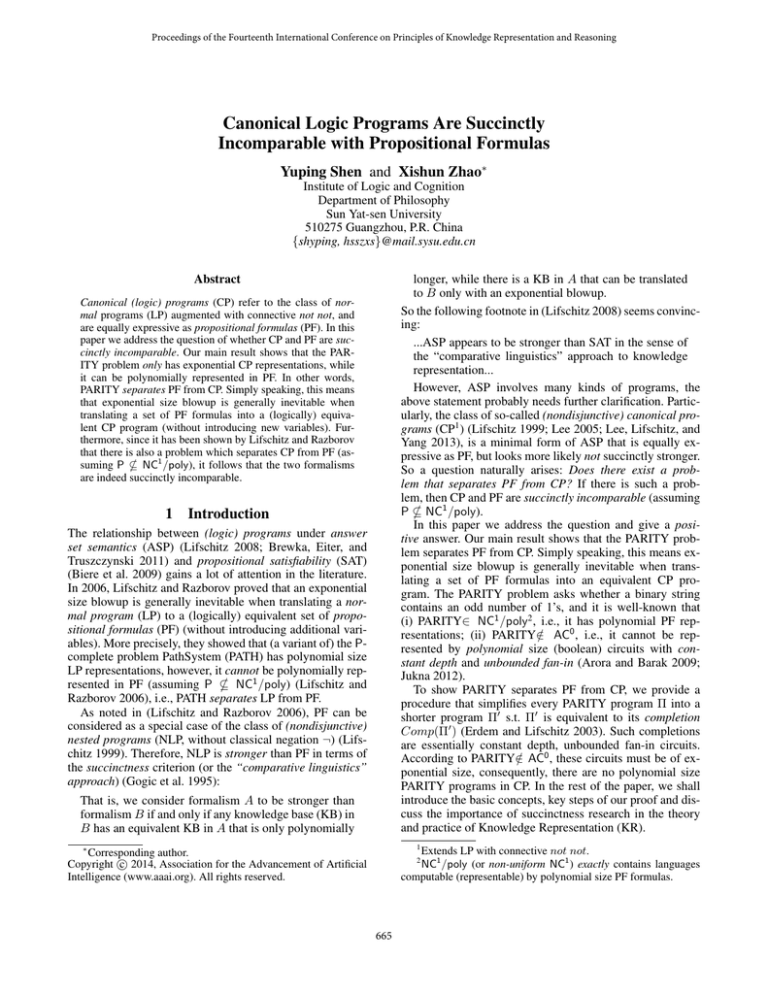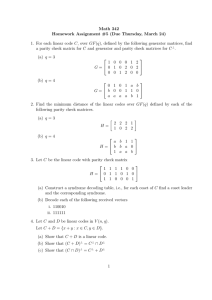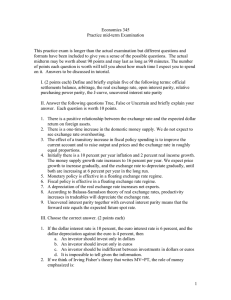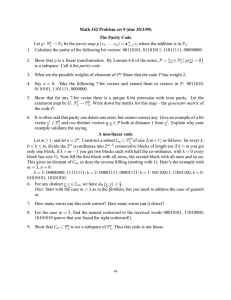
Proceedings of the Fourteenth International Conference on Principles of Knowledge Representation and Reasoning
Canonical Logic Programs Are Succinctly
Incomparable with Propositional Formulas
Yuping Shen and Xishun Zhao∗
Institute of Logic and Cognition
Department of Philosophy
Sun Yat-sen University
510275 Guangzhou, P.R. China
{shyping, hsszxs}@mail.sysu.edu.cn
longer, while there is a KB in A that can be translated
to B only with an exponential blowup.
So the following footnote in (Lifschitz 2008) seems convincing:
...ASP appears to be stronger than SAT in the sense of
the “comparative linguistics” approach to knowledge
representation...
However, ASP involves many kinds of programs, the
above statement probably needs further clarification. Particularly, the class of so-called (nondisjunctive) canonical programs (CP1 ) (Lifschitz 1999; Lee 2005; Lee, Lifschitz, and
Yang 2013), is a minimal form of ASP that is equally expressive as PF, but looks more likely not succinctly stronger.
So a question naturally arises: Does there exist a problem that separates PF from CP? If there is such a problem, then CP and PF are succinctly incomparable (assuming
P * NC1 /poly).
In this paper we address the question and give a positive answer. Our main result shows that the PARITY problem separates PF from CP. Simply speaking, this means exponential size blowup is generally inevitable when translating a set of PF formulas into an equivalent CP program. The PARITY problem asks whether a binary string
contains an odd number of 1’s, and it is well-known that
(i) PARITY∈ NC1 /poly2 , i.e., it has polynomial PF representations; (ii) PARITY∈
/ AC0 , i.e., it cannot be represented by polynomial size (boolean) circuits with constant depth and unbounded fan-in (Arora and Barak 2009;
Jukna 2012).
To show PARITY separates PF from CP, we provide a
procedure that simplifies every PARITY program Π into a
shorter program Π0 s.t. Π0 is equivalent to its completion
Comp(Π0 ) (Erdem and Lifschitz 2003). Such completions
are essentially constant depth, unbounded fan-in circuits.
According to PARITY∈
/ AC0 , these circuits must be of exponential size, consequently, there are no polynomial size
PARITY programs in CP. In the rest of the paper, we shall
introduce the basic concepts, key steps of our proof and discuss the importance of succinctness research in the theory
and practice of Knowledge Representation (KR).
Abstract
Canonical (logic) programs (CP) refer to the class of normal programs (LP) augmented with connective not not, and
are equally expressive as propositional formulas (PF). In this
paper we address the question of whether CP and PF are succinctly incomparable. Our main result shows that the PARITY problem only has exponential CP representations, while
it can be polynomially represented in PF. In other words,
PARITY separates PF from CP. Simply speaking, this means
that exponential size blowup is generally inevitable when
translating a set of PF formulas into a (logically) equivalent CP program (without introducing new variables). Furthermore, since it has been shown by Lifschitz and Razborov
that there is also a problem which separates CP from PF (assuming P * NC1 /poly), it follows that the two formalisms
are indeed succinctly incomparable.
1
Introduction
The relationship between (logic) programs under answer
set semantics (ASP) (Lifschitz 2008; Brewka, Eiter, and
Truszczynski 2011) and propositional satisfiability (SAT)
(Biere et al. 2009) gains a lot of attention in the literature.
In 2006, Lifschitz and Razborov proved that an exponential
size blowup is generally inevitable when translating a normal program (LP) to a (logically) equivalent set of propositional formulas (PF) (without introducing additional variables). More precisely, they showed that (a variant of) the Pcomplete problem PathSystem (PATH) has polynomial size
LP representations, however, it cannot be polynomially represented in PF (assuming P * NC1 /poly) (Lifschitz and
Razborov 2006), i.e., PATH separates LP from PF.
As noted in (Lifschitz and Razborov 2006), PF can be
considered as a special case of the class of (nondisjunctive)
nested programs (NLP, without classical negation ¬) (Lifschitz 1999). Therefore, NLP is stronger than PF in terms of
the succinctness criterion (or the “comparative linguistics”
approach) (Gogic et al. 1995):
That is, we consider formalism A to be stronger than
formalism B if and only if any knowledge base (KB) in
B has an equivalent KB in A that is only polynomially
1
∗
Extends LP with connective not not.
NC1 /poly (or non-uniform NC1 ) exactly contains languages
computable (representable) by polynomial size PF formulas.
Corresponding author.
c 2014, Association for the Advancement of Artificial
Copyright Intelligence (www.aaai.org). All rights reserved.
2
665
2
Background
Problem Representation and Succinctness
A (binary) string is a finite sequence of bits from {0, 1}.
A string w of length n (i.e., w ∈ {0, 1}n ) defines a subset
of variables {x1 , . . . , xn }. E.g., 1010 stands for {x1 , x3 }.
Therefore, a set of variables I and a string w can be regarded
as the same. A problem (or language ) L is a set of strings.
Canonical Programs
The following notations are adopted from (Lifschitz 1999;
Lee 2005). A rule element e is defined as
e := > | ⊥ | x | not x | not not x
in which >, ⊥ are 0-ary connectives, x is a (boolean) variable (or an atom) and not is a unary connective3 . A (nondisjunctive canonical) rule is an expression of the form
H← B
Definition 2.1 (Problem Representation). A problem L
can be represented in a class of programs (or formulas, etc)
C (i.e., L ∈ C), if there exists a sequence of programs {Πn }
(n = 1, 2, . . .) in C that computes L, i.e., for every string
w ∈ {0, 1}n ,
(1)
where the head H is either a variable or the connective ⊥,
and the body B is a finite set of rule elements. A canonical
program Π is a finite set of rules. E.g., the following is a
canonical program:
x1 ← not not x1 , x3 ← not x1 , not x2 ,
(2)
x2 ← not not x2 , x3 ← x1 , x2 .
w ∈ L ⇔ w ∈ Ans(Πn ).
Say L has polynomial representations in C (i.e., L ∈
Poly-C), if L ∈ C and |Πn | is bounded by a polynomial p(n).
Recall that the PARITY problem is the set of binary
strings with an odd number of 1’s. By PARITYn we denote PARITY strings of length n. Clearly, (2) represents
PARITY3 since its answer sets are 111, 100, 010 and 001.
A canonical program Π is normal if it contains no connectives not not. A normal program Π is basic if it contains no
occurrences of connective not.
The satisfaction relation |= between a set of variables I
and a rule element is defined as follows:
• I |= > and I 2 ⊥,
• I |= x iff I |= not not x iff x ∈ I,
• I |= not x iff x ∈
/ I.
Say I satisfies a set of rule elements B if I satisfies each
rule element in B. We say I is closed under a program
Π, if I is closed under every rule in Π, i.e., for each rule
H ← B ∈ Π, I |= H whenever I |= B. Let Π be a basic
program and let Cn(Π) denotes the minimal set (in terms of
set inclusion) closed under Π, we say I is an answer set of
Π if I = Cn(Π). Note that a basic program has exactly one
answer set.
The reduct ΠI of a program Π w.r.t. I is a set of rules
obtained from Π via: (i) Replacing each not not x with >
if I |= x, and with ⊥ otherwise; (ii) Replacing each not x
with > if I 2 x, and with ⊥ otherwise. Observe that ΠI
must be a basic program. We say I is an answer set of Π
if I = Cn(ΠI ), i.e., I is an answer set of ΠI . E.g., the
following single rule program:
x ← not not x
Definition 2.2 (Succinctness (Gogic et al. 1995; French et
al. 2013)). Let C, C 0 be two classes of programs such that
for every problem L, L ∈ C ⇔ L ∈ C 0 . Say C is at least as
succinct as C 0 (i.e., C 0 C), if for every problem L,
L ∈ Poly-C 0 ⇒ L ∈ Poly-C.
If L ∈ Poly-C but L 6∈ Poly-C 0 (i.e., C 6 C 0 ), then L separates C from C 0 . If C 0 C and C 6 C 0 , then C is strictly more
succinct than C 0 (i.e., C 0 ≺ C). Moreover, C, C 0 are succinctly
incomparable if there is a problem L that separates C from
C 0 , and vice versa ( i.e., C 6 C 0 and C 0 6 C).
PARITY Representations and Completion
Note that (2) suggests a “pattern” for PARITYn : The first
part of the program (e.g., the “not not” rules in (2)) generates all possible strings of length n − 1, the second part
identifies the last bit to form an odd string of length n. Following the pattern, we can give a sequence of exponential
size CP programs for PARITY, i.e., PARITY∈CP.
On the other hand, it is a textbook result that PARITY
has polynomial size PF representations with classical connectives {∧, ∨, ¬}, i.e., PARITY∈ NC1 /poly (or Poly-PF).
Remind that the size of a formula is the number of its connectives. E.g., (x1 ∧¬x2 )∨(¬x1 ∧x2 ) represents PARITY2 ,
and the formula can be recursively applied for arbitrary
PARITYn . It is also well-known that PARITY∈
/ AC0 , i.e.,
PARITY cannot be represented by a sequence of polynomial size circuits {Cn } in which these circuits Cn have unbounded fan-in and constant depth.
Simply speaking, a sequence of polynomial size PF formulas {φn } represents an AC0 language, if the number of
variables occur in a conjunction or disjunction of φn is unrestricted, and the distance of the longest path from the root
to a leaf in the tree structure of each φn is fixed. E.g., PARITY cannot be represented by a sequence of polynomial
size CNFs {ψn } since {ψn } represents an AC0 language.
For more details about circuits, please see (Arora and Barak
2009; Jukna 2012).
(3)
has two answer sets ∅ and {x}.
For a set of rule elements B, define var(B) = {e ∈
B : e is a variable}. E.g., var({x1 , not x2 , not not x3 }) =
{x1 }. The signature sig(Π) of a program Π is the
set of all involved variables in Π. By Ans(Π) we denote the set of all answer sets of Π. E.g., if Π is
(2), then sig(Π) = {x1 , x2 , x3 } and Ans(Π) =
{{x1 , x2 , x3 }, {x1 }, {x2 }, {x3 }}. The size |Π| of Π is the
number of its rules. As a convention, Πn refers to a program
with signature {x1 , . . . , xn }, i.e., sig(Πn ) = {x1 , . . . , xn }.
It is easy to see that by using rules of the form (3) and
appropriate constraints of the form ⊥ ← B, it is easy to
give an arbitrary set of answer sets over sig(Πn ), in other
words, CP has exactly the same expressive power as PF.
3
By (Lifschitz 1999), not not not x can be replaced by not x.
666
The completion Comp(Π) (Erdem and Lifschitz 2003) of
a CP program Π consists of a set (or a conjunction) of PF
formulas (we slightly abuse the connective ≡): (i) x ≡ B̃1 ∨
B̃2 ∨ · · · ∨ B̃m , where x ← B1 , . . . , x ← Bm are all rules
in Π with head x, and each B̃i is the conjunction of rule
elements in Bi with connective not replaced by ¬; (ii) x ≡
⊥, if x is not a head of any rule in Π; (iii) ¬B̃, if a rule
⊥ ← B is in Π.
Proposition 2.1. The completion Comp(Π) of an arbitrary
canonical program Π is a constant depth, unbounded fan-in
circuit whose size is polynomially bounded by |Π|.
It is well-known that an answer set of Π is also a model of
its completion, but the inverse generally does not hold. E.g.,
the completion {x1 ≡ ¬x2 ∨(x2 ∧x1 ), x2 ≡ ¬x1 ∨(x1 ∧x2 )}
of the PARITY2 program:
x1 ← not x2 ,
x2 ← not x1 ,
x1 ← x2 , not not x1 , x2 ← x1 , not not x2 ,
Moreover, note that (2) and (5) are completion-equivalent
PARITY programs. This is guaranteed by the following
proposition:
Proposition 3.2. Let Πn be a standard PARITYn program.
Then Πn is equivalent to its completion Comp(Πn ).
The proof idea of Proposition 3.2 is that every standard
PARITYn program Πn can be equivalently rewritten to Π0n
by replacing each x ∈ var(B) with not not x for every rule
body B in Πn . By the Lin-Zhao Theorem (Lin and Zhao
2004) or the (generalized) Fages Theorem (Erdem and Lifschitz 2003; You, Yuan, and Zhang 2003), Π0n is equivalent
to its completion Comp(Π0n ). And then the Proposition follows from the fact that Comp(Π0n ) = Comp(Πn ).
Lemma 3.3 (Main Lemma). Let Πn be a PARITYn program. Then there is a PARITYn program Π0n s.t. Π0n is equivalent to Comp(Π0n ) and |Π0n | ≤ |Πn |.
(4)
Theorem 3.1 (PARITY∈Poly-CP).
/
PARITY has no polynomial size CP representations.
has an even string model 11, i.e., (4) is not completionequivalent. In the next section, we will show how to simplify
a PARITY program to be completion-equivalent.
3
Proof. Assume the contrary that there is a sequence of
PARITYn programs {Πn } s.t. |Πn | is bounded by a polynomial p(n). By Lemma 3.3, there is a sequence of
completion-equivalent PARITYn programs {Π0n } in which
|Π0n | is also bounded by the polynomial p(n). By Proposition 2.1, {Π0n } represents a language in AC0 . This contradicts PARITY∈
/ AC0 .
Simplifying PARITY Programs
Let B be a finite set of rule elements built on signature V = {x1 , . . . , xn }. By S(B) we denote the set
{I ⊆ V : I |= B}. E.g., let V = {x1 , x2 , x3 , x4 }
and B = {x2 , not x3 , not not x4 }, then S(B) =
{{x1 , x2 , x4 }, {x2 , x4 }} = {1101, 0101}. We say B is consistent if there is a set of variables I s.t. I |= B. We say
B covers a variable x ∈ V iff x ∈ B or not x ∈ B or
not not x ∈ B. If B covers every variable in V then B fully
covers V . E.g., B = {x1 , not x2 , not not x3 } fully covers
V = {x1 , x2 , x3 }. Clearly, B is consistent and fully covers
V iff S(B) contains a unique string.
In the following we assume that all rules x ← B have
consistent body B and x ∈
/ var(B). It is easy to see that the
assumption does not affect the generality.
Lemma 3.1. Let Πn be a PARITYn program. If there is a
rule x ← B in Πn s.t. not not x ∈ B and S(B) contains
a unique even string, then dropping x ← B from Πn results
in a PARITYn program Π0n .
E.g., by Lemma 3.1, (4) can be simplified to:
x1 ← not x2 ,
x2 ← not x1 .
Corollary 3.1. PARITY separates PF from CP.
Corollary 3.2. Suppose P * NC1 /poly. Then CP and PF
are succinctly incomparable.
4
Discussion and Conclusion
In this paper we show that the PARITY problem separates
PF from CP, and the two formalisms are succinctly incomparable (assuming P * NC1 /poly). Interestingly, our main
result may at first appear counter-intuitive: the P-complete
problem PATH has Poly-CP representations, while this does
not hold for an “easy” problem PARITY. Actually, there is
no contradiction. As noted in (Abiteboul, Hull, and Vianu
1995; Dantsin et al. 2001), a complete problem in a complexity class can be represented in a formalism C, does not
imply that all problems in that class can be represented in C.
Generally speaking, the research of succinctness (Gogic
et al. 1995; Coste-Marquis et al. 2004; Grohe and
Schweikardt 2005; French et al. 2013) gives us a deeper
understanding about KR formalisms, for it reveals their
(in)abilities of concisely representing different problems under the condition that the encoded models are the same. This
is particularly interesting if the formalisms are equally expressive and share the same reasoning complexity.
E.g., in addition to CP and NLP, programs with cardinality constraints and choice rules (CC, without classic negation ¬) (Simons, Niemelä, and Soininen 2002), (simple) definite causal theories4 (S/DT) (Giunchiglia et al. 2004) and
(5)
Lemma 3.2. Let Πn be a PARITYn program. If there is a
rule x ← B in Πn s.t. not not x ∈ B and S(B) contains a
unique odd string, then dropping not not x from B results
in a PARITYn program Π0n .
Standard Programs and the Main Theorem
A PARITYn program Πn is standard if for each rule x ←
B ∈ Πn , not not x ∈
/ B whenever S(B ∪ {x}) contains
a unique string. E.g., (2) and (5) are standard programs. By
Lemma 3.1 and 3.2, it is not hard to see:
Proposition 3.1. Let Πn be a PARITYn program. Then there
is a standard PARITYn program Π0n s.t. |Π0n | ≤ |Πn |.
4
667
A theory is simple if each rule body is a conjunction of literals.
two-valued programs (TV) (Lifschitz 2012) are as expressive as PF and NP-complete for consistency checking. But
they have a non-trivial succinctness picture, see Fig. 1.
Besides the theoretical interests, succinctness also tells
us something like “which for what is the best” in choosing KR formalisms for a given application. E.g., one should
choose ASP instead of SAT (or DT) if the application involves reasoning about PATH or Transitive Closure5 , because the former provides compact representations to avoid
unnecessary overload. Recall that from the complexity viewpoint, even one extra variable may double the search space
for intractable problems.
In future work we
plan to establish the
*
missing connections in
*
SDT
TV
Fig. 1, moreover, we
will consider the suc*
cinctness of more ex*
DT
PF
CP
*
pressive formalisms like
programs with predicate
*
*
symbols or higher-order
CC
NLP
atoms (Gebser, Schaub,
A
B :A B
and Thiele 2007), etc.
A
*
B :∃L separates A from B
: under assumption
Erdem, E., and Lifschitz, V. 2003. Tight logic programs.
Theory and Practice of Logic Programming 3(4):499–518.
French, T.; van der Hoek, W.; Iliev, P.; and Kooi, B. P. 2013.
On the succinctness of some modal logics. Artificial Intelligence 197:56–85.
Gebser, M.; Schaub, T.; and Thiele, S. 2007. Gringo: A new
grounder for answer set programming. In Proceedings of
the 9th International Conference of Logic Programming and
Nonmonotonic Reasoning (LNCS4483), 266–271. Springer.
Giunchiglia, E.; Lee, J.; Lifschitz, V.; McCain, N.; Turner,
H.; and Lifschitz, J. L. V. 2004. Nonmonotonic causal theories. Artificial Intelligence 153(1-2):49–104.
Gogic, G.; Kautz, H. A.; Papadimitriou, C. H.; and Selman,
B. 1995. The comparative linguistics of knowledge representation. In Proceedings of the Fourteenth International
Joint Conference on Artificial Intelligence, 862–869. Morgan Kaufmann Publishers Inc.
Grohe, M., and Schweikardt, N. 2005. The succinctness of
first-order logic on linear orders. Logical Methods in Computer Science 1(1).
Jukna, S. 2012. Boolean Function Complexity - Advances
and Frontiers. Springer.
Lee, J.; Lifschitz, V.; and Yang, F. 2013. Action language
BC: Preliminary report. In Proceedings of the 23rd International Joint Conference on Artificial Intelligence, 983–989.
AAAI Press.
Lee, J. 2005. A model-theoretic counterpart of loop formulas. In Proceedings of the 19th international joint conference on Artificial intelligence, 503–508. Morgan Kaufmann
Publishers Inc.
Lifschitz, V., and Razborov, A. 2006. Why are there so many
loop formulas? ACM Transactions on Computational Logic
7(2):261–268.
Lifschitz, V. 1999. Nested expressions in logic programs.
Annals of Mathematics and Artificial Intelligence 25:369–
389.
Lifschitz, V. 2008. What is answer set programming? In
Proceedings of the AAAI Conference on Artificial Intelligence, 1594–1597. MIT Press.
Lifschitz, V. 2012. Two-valued logic programs. In Technical
Communications of the 28th International Conference on
Logic Programming, 259–266. Schloss Dagstuhl - LeibnizZentrum fuer Informatik.
Lin, F., and Zhao, Y. 2004. ASSAT: computing answer sets
of a logic program by SAT solvers. Artificial Intelligence
157(1 - 2):115 – 137.
Simons, P.; Niemelä, I.; and Soininen, T. 2002. Extending and implementing the stable model semantics. Artificial
Intelligence 138(1-2):181–234.
You, J.-H.; Yuan, L.-Y.; and Zhang, M. 2003. On the equivalence between answer sets and models of completion for
nested logic programs. In Proceedings of the 18th international joint conference on Artificial intelligence, 859–864.
Morgan Kaufmann Publishers Inc.
Acknowledgement
We are grateful to the
anonymous
reviewers for their valuable
comments. Thanks to
Shiguang Feng, Yan Zhang, Jiankun He, Guangrui Dang and
Xiaolong Liang for their helpful discussions. The research
was partially supported by NSFC Grant 61272059, MOE
Grant 11JJD720020, NSSFC Grant 13&ZD186 and the
Fundamental Research Funds for the Central Universities
Grant 1409025.
Figure 1: Succinctness Pic.
References
Abiteboul, S.; Hull, R.; and Vianu, V. 1995. Foundations of
Databases. Addison-Wesley.
Arora, S., and Barak, B. 2009. Computational Complexity:
A Modern Approach. Cambridge University Press.
Biere, A.; Heule, M.; van Maaren, H.; and Walsh, T., eds.
2009. Handbook of Satisfiability, volume 185 of Frontiers
in Artificial Intelligence and Applications. IOS Press.
Brewka, G.; Eiter, T.; and Truszczynski, M. 2011. Answer
set programming at a glance. Communications of the ACM
54(12):92–103.
Coste-Marquis, S.; Lang, J.; Liberatore, P.; and Marquis, P.
2004. Expressive power and succinctness of propositional
languages for preference representation. In Proceedings of
the Ninth International Conference on Principles of Knowledge Representation and Reasoning, 203–212. AAAI Press.
Dantsin, E.; Eiter, T.; Gottlob, G.; and Voronkov, A. 2001.
Complexity and expressive power of logic programming.
ACM Computing Surveys 33(3):374–425.
5
An NL-complete problem. It is believed that NL * NC1 /Poly.
668







